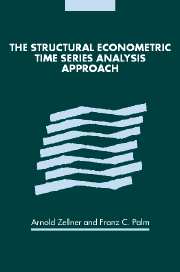Book contents
- Frontmatter
- Contents
- List of contributors
- Acknowledgments
- Introduction
- Part I The SEMTSA approach
- 1 Time series analysis and simultaneous equation econometric models (1974)
- 2 Statistical analysis of econometric models (1979)
- 3 Structural econometric modeling and time series analysis: an integrated approach (1983)
- 4 Time series analysis, forecasting, and econometric modeling: the structural econometric modeling, time series analysis (SEMTSA) approach (1994)
- 5 Large-sample estimation and testing procedures for dynamic equation systems (1980)
- Part II Selected applications
- Part III Macroeconomic forecasting and modeling
- Part IV Disaggregation, forecasting, and modeling
- Subject index
- Author index
- References
4 - Time series analysis, forecasting, and econometric modeling: the structural econometric modeling, time series analysis (SEMTSA) approach (1994)
Published online by Cambridge University Press: 24 October 2009
- Frontmatter
- Contents
- List of contributors
- Acknowledgments
- Introduction
- Part I The SEMTSA approach
- 1 Time series analysis and simultaneous equation econometric models (1974)
- 2 Statistical analysis of econometric models (1979)
- 3 Structural econometric modeling and time series analysis: an integrated approach (1983)
- 4 Time series analysis, forecasting, and econometric modeling: the structural econometric modeling, time series analysis (SEMTSA) approach (1994)
- 5 Large-sample estimation and testing procedures for dynamic equation systems (1980)
- Part II Selected applications
- Part III Macroeconomic forecasting and modeling
- Part IV Disaggregation, forecasting, and modeling
- Subject index
- Author index
- References
Summary
In this chapter an account of our experiences in modeling and forecasting the annual output growth rates of 18 industrialized countries is presented. A structural econometric modeling, time-series analysis (SEMTSA) approach is described and contrasted with other approaches. Theoretical and applied results relating to variable and model selection and point and turning-point forecasting are discussed. A summary of results and directions for future research concludes the chapter.
Introduction
In this chapter we shall provide an account of some of our experiences in modeling, forecasting, and interpreting time series data. Since the literature on these topics is so extensive, a comprehensive survey would require one or probably more volumes. Thus, we have decided to describe our approach, the experience that we have had with it, and its relation to a part of the statistical and econometric time series literature.
Obtaining good macroeconomic and microeconomic and other time series models is important since they are useful in explanation, prediction, and policy-making or control. The basic issue that is addressed in this chapter is how to produce such good time series models. Our SEMTSA approach (see, e.g., Zellner and Palm 1974, 1975; Plosser 1976, 1978; Zellner 1979, 1984, 1991; Palm 1983; Wallis 1983; Webb 1985; Manas-Anton 1986; Hong 1989; Min 1991) will be briefly compared to several other approaches that have emerged in the literature. Rather than just present theoretical procedures that may be useful in producing good models, an account will be given of both theoretical and applied results in what follows.
- Type
- Chapter
- Information
- The Structural Econometric Time Series Analysis Approach , pp. 175 - 200Publisher: Cambridge University PressPrint publication year: 2004

